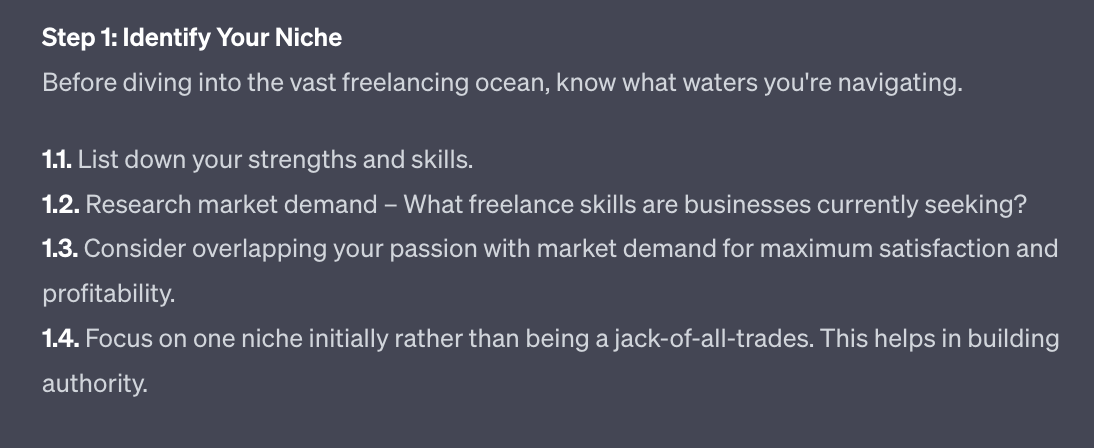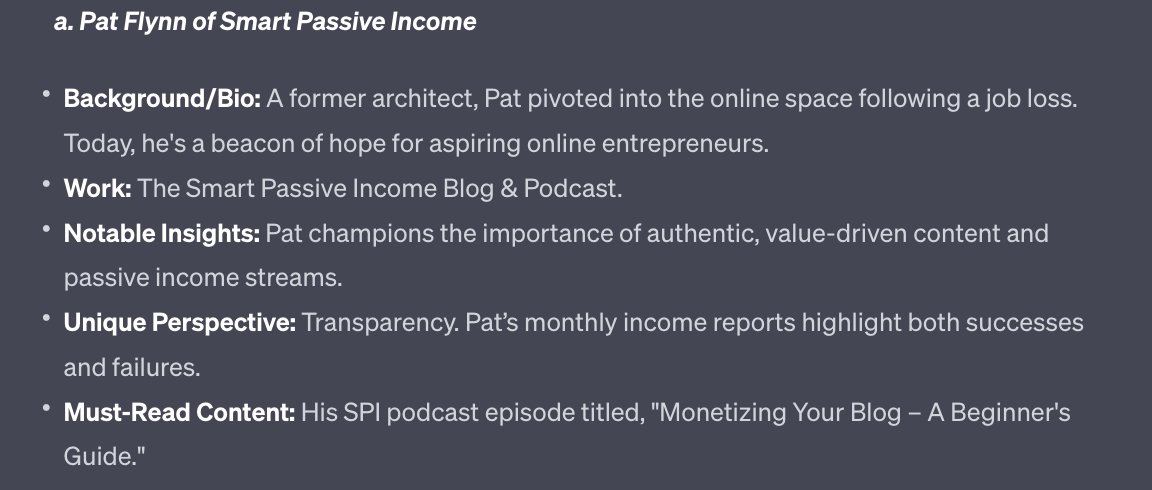Hey Prompt Entrepreneur,
We now move into the core content creation we need to get our SEO rolling.
We have put in place the structure required to start ranking – now we’re filling that structure with content so as to get noticed by Google and begin the process of moving up the ranks.
In this Part we’ll focus on longer form content. In the next part we’ll look at shorter form pieces.
Both long form and short form content should be tailored to your particular niche. Some formats will be more relevant than others. The purpose of these Parts is to arm you with a range of prompt templates to choose from.
Let’s get started:
Long form content
1. How-to guide format
Our first type of long form content is a how-to piece.
This content is primarily educational and it fulfils one of the main reasons people come to Google: to solve problems.
For example I recently needed to reseal a sink. I had no idea how to do this so Googled “how to seal a sink”.
The top results were guides showing me what tools I needed and then a step-by-step guide to sealing the sink.
Check your keyword list and you’ll see lots of keywords with “how” in them. These are the perfect candidates for How-to contents.
Don’t limit yourself to only those keywords though – you can basically place “how” in front of any keyword and come up with a relevant guide topic.
For example if a keyword is “cold brew coffee” that can easily become “How to make Cold Brew Coffee at Home” or a similarly titled guide.
Here’s the prompt:
Act as an SEO expert.
Write a long form how-to guide on the topic: how to [keyword]
Give me 5 SEO optimised titles and subtitles that use the keyword.
Use SEO optimised subheaders throughout.
1. Introduction
Grab the reader's attention with an interesting fact or story relating to the topic
Briefly explain what the guide will cover and why it's useful
2. Necessary Materials/Ingredients
Make a list of any tools, ingredients, or materials needed to complete the task
3.Step-by-Step Instructions
Break down the process into clear, sequential steps
Number each step and explain it in detail
Suggest helpful visuals like photos, diagrams, or screenshots as needed
Provide tips, warnings, or troubleshooting advice where relevant
4.Conclusion
Summarize the main steps briefly
Reiterate the benefits of following the guide
Invite the reader to get in touch with any questions
Some additional sections you could include:
5. Background information or context to help readers understand the topic
A frequently asked questions section to address common issues
Variations or customizations for how to tweak the process
A glossary defining key terms
Related resources for more information
Write in an educational, highly readable tone. The goal is to move the reader from one sentence to the next easily.
The whole piece should be 2000+ words
Give me the entire piece, do not ask me to expand. For this example I used the keyword “make money from freelancing” which turns this into a “How to Make Money from Freelancing” article.
Prompt Output 💬

ChatGPT will create a detailed how-to guide with required resources, step by step instructions, FAQs and additional resources.
This is ready to go as a basic post. However feel free to expand on sections. For instance I think those step by steps are a bit sparse so I’d ask ChatGPT to expand using “Expand on the step by step instructions so that each step has it’s own instructions to follow. Be detailed so that the reader can follow through without requiring additional research”
That gives me a much more detailed output. For example Step 1 is fleshed out as so:

These sub-steps can also be fleshed out if required. There’s no limit to how deep you go.
In fact each of these sub-steps could actually be its own blog article.
2. Shout out post format
Another long form post you can create is talking about other websites and influencers in your niche.
This seems counterintuitive. Why would we want to talk about others rather than ourselves?
Doing so allows us to build authority in the eyes of our readers. If we just try and sell them stuff they’ll be turned off. If instead we discuss other people in the industry and how great they are we are putting ourselves into a position of expertise.
Better than this if we link out to other people in our market they may also link back to use or give us shout outs in the future. Win-win.
Here’s the prompt:
Act as an SEO expert
Write a long form shout out post to highlight experts on the keyword : [keyword]
Give me 5 SEO optimised titles and subtitles that use the keyword.
Use SEO optimised subheaders throughout.
1. Introduction
Explain the topic area and why you want to highlight experts in this field
Share your criteria for who qualifies as an "expert" in this domain
2.Featured Experts
For each expert profiled, include:
Brief background/bio
Description of their work (books, podcast, blog, etc.)
Notable ideas, insights or contributions they've made
What makes their perspective unique or valuable
Examples of their best or most influential content
Organize and group experts logically, such as by platform, experience level, niche topics, etc.
Include quotes, key takeaways, or examples directly from the experts on the topic
Synthesize and discuss their perspectives on various aspects of the topic
Encourage readers to check out the featured experts' work
Provide links, podcast episode titles, book recommendations, etc. to help readers dive in
Suggest ideas for who to follow, listen to, or read next based on their interests
3. Conclusion
Recap the key benefits of paying attention to experts and thought leaders
Express excitement about learning from these and other experts in the field
Invite readers to connect with you to continue the conversation
Write in an educational, highly readable tone. The goal is to move the reader from one sentence to the next easily.
The whole piece should be 2000+ words
Give me the entire piece, do not ask me to expand. I plugged in the keyword “making money online” to generate a piece. The below example is a snippet.
Prompt Output 💬

Here’s just one (of many) influencers highlighted in ChatGPT’s output.
I recommend setting up links to the expert’s work. You can use Google to find the examples given by ChatGPT.
Alternatively, and if you have access, use Claude 2 for this job due to its ability to better provide web addresses.
As before if you want to expand any particular sections go ahead and ask ChatGPT to do so.
3. Skyscraper format
Skyscraper content is a concept taught by Brian Dean of Backlinko. This is a great article that goes into depth about how it works.
The basic idea is you want to find a piece of content that a competitor has created that lots of people find valuable.
Then you create a “better” version of the same thing.
Better here could, for example, be longer.
If the competitor has an article on “15 ways to make money online” you could make an article with “99 ways to make money online”.
Better could also be specificity. If a competitor has an article on “how to make money online” you could have a more specific version “how to make money online from Indonesia in 2023”.
In both examples you are making a bigger, better skyscraper.
How to find an article to improve?
The simplest method is simply Googling your keyword.
If I put “how to make money online” in Google I get this as a top result: 40 easy ways to make money quickly.
Nice easy way to skyscraper this is to increase the number to 65 easy ways. Not rocket science!
Act as an SEO writer
Create a blog article called [blog title]
Focusing on the keyword: [keyword]
Use the formatting and content style of the example piece I will provide.
Give me 5 SEO optimised titles and subtitles that use the keyword.
Use SEO optimised subheaders throughout.
Write in an educational, highly readable tone. The goal is to move the reader from one sentence to the next easily.
The whole piece should be 2000+ words
Give me the entire piece, do not ask me to expand.
##Example piece begins##
[copy paste competitor content here]
Plug in the original keyword – here it was “make money online”.
Give it a new title to skyscraper the content. Instead of 40 ways I use “65 ways to make money online”
Finally copy paste the whole of the competitors article below the prompt. You may need to use Claude 2 for its larger text input. Alternatively put the text of the website into a .txt file and upload it into ChatGPT’s Code Interpreter along with the original prompt. Either will allow you to work with more text.
Prompt Output 💬

In this output you can see we’ve gone beyond the initial 40 ideas that were in the competitor’s original article.
Use this method to outmanoeuvre competitors by doing what they have done … better!
Pulling it together
We’ve just covered three powerful methods to make long form valuable posts for your readers and for Google.
A question I always get here is which format you should apply to each keyword.
One answer here is that you can actually apply multiple formats to a single keyword.
I could for example have a how to guide, a suggested expert list and a skyscraper post about “how to make money online”. That’s just more valuable content on my website.
What you’ll tend to find as you work through your list is that certain formats work better with certain keywords. This will depend on your niche so use your judgement here.
We’ll talk more in the final Part about how many posts to create and on what schedule. So for now just experiment with producing content and getting it published.
A reminder of this week:
Part 1: What is SEO + Keyword Research
Part 2: SEO structure and setup
Part 3: Long form content
Part 4: Short form content
Part 5: SEO optimisation
